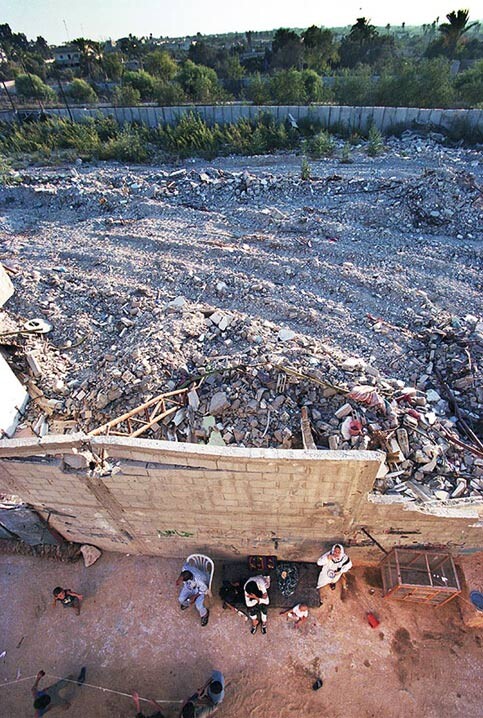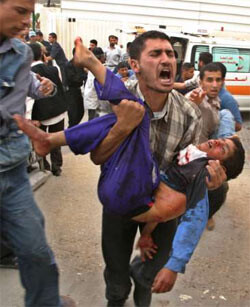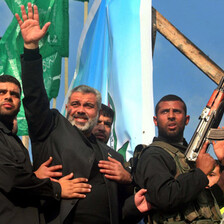The Electronic Intifada 19 May 2004

A family in Rafah sitting in front of the precarious wall of a demolished home. Behind the wall, what Israel has termed the “Philadelphia Corridor”, a no-man’s land between Rafah and Egypt, formed from the rubble of demolished Palestinian homes and watched over by Israeli sniper towers. (Ronald de Hommel)
Overview: Rafah and the “Philadelphia corridor”
The official Israeli government Cabinet Communique of 16 May 2004 recorded that
”IDF Chief-of-Staff Lt.-Gen. Moshe Ya’alon briefed ministers on the atrocious terror attack on the Hatuel family, on the events in the Zeitoun neighborhood and the Philadelphia corridor, and on the IDF operations in those areas.”[1]
It was left to other media to report the details. Voice of America reported that:
“The head of Israel’s army, General Moshe Ya’alon, told the cabinet it might be necessary to destroy hundreds of Palestinian homes in the Rafah refugee camp in order to improve security.“[2]
The “Philadelphia corridor” — also referred to by Israel as the “Philadelphi Road” or “Pink Area” — is Israel’s term for a strip of land between Rafah, on the border of Gaza, and Egypt that the state has been in the process of structurally and ethnically cleansing since the beginning of the Second Palestinian Intifada.
In a 16 May 2004 Washington Post article, Molly Moore wrote:
“During the same 31/2-year period, Israeli military bulldozers have crushed 1,218 houses along the northern edge of the border between Gaza and Egypt, pushing back the city of Rafah and the adjacent refugee camp. A mile-long swath of broken concrete, splintered wood and twisted metal is all that remains of what Azizah Abu Anzah and others say was a close-knit community built by families and neighbors who gathered here a half-century ago in a cluster of U.N. tents.”[3]
The United Nations Relief and Works Agency (UNRWA) reports that 12,600 Palestinians in Rafah — 14% of the population of 90,638 registered refugees — have been made homeless since the beginning of the Intifada.[4]
Since the beginning of May 2004, Israel has dramatically increased its program of structural and ethnic cleansing of Rafah. UNRWA reported on May 10th that:
“The destruction in the first 10 days of May brings the total number of people to lose their homes in the Gaza Strip to 17,594. The majority of the demolitions this month have taken place in Rafah in the south of the Gaza Strip, where 11,215 people had already been made homeless by demolitions since the start of the current strife, and in the region of the Kissufim Road, where a Palestinian attack on May 2 left an Israeli mother and her four children dead.”[5]
While Israel claims that its military operations in Rafah are motivated by “security reasons”, numerous reports from human rights organisations paint a picture of arbitrary shootings of residents, including children, and nightly firing at border homes from Israeli watchtowers. Three internationals — Rachel Corrie (peace activist, US), Tom Hurndall (photographer, UK), and James Miller (cameraman, UK) — have been killed by Israeli troops in Rafah.
Israel’s current military operations in Rafah are no different, with multiple reports of grave human rights violations reported in the media and by local and international human rights organisations. “Operation Rainbow” coincided with the release of a new report on the Israeli practice of home demolition by human rights organisation Amnesty International, which concluded that, “The grounds invoked by Israel to justify the destruction are overly broad and based on discriminatory policies and practices,” adding, “According to Article 147 of the Fourth Geneva Convention, ‘extensive destruction and appropriation of property, not justified by military necessity and carried out unlawfully and wantonly’ is a grave breach, and hence, a war crime.”[6]
This article examines the various claims Israel has made about the ongoing “Operation Rainbow” and attempts to uncover some of the realities behind Israel’s distortions of what is happening in Rafah.
Israel’s rationale for “Operation Rainbow”

A map of Gaza, showing Rafah at bottom left. (UNRWA)
Both IDF Chief-of-Staff Lt.-Gen. Moshe Ya’alon[1] and Defense Minister Shaul Mofaz stated on 16 May 2004 that it is Israel’s intention to demolish “hundreds of buildings” in Rafah “as part of the plan to widen the Philadelphi Route. IDF Chief of Staff Lt.-Gen. Moshe Ya’alon commented that the houses have already been marked in aerial photos.”[8]
The Christian Science Monitor reported on 17 May 2004 that:
The idea is to widen the Philadelphia Corridor to about 500 yards, from its current width of about 250 yards, according to Arye Eldad, a far-right coalition legislator who serves on the Knesset’s Foreign Affairs and Defense Committee.[22]
While these statements were widely reported and certainly available to journalists covering the region, much subsequent and current coverage of the events in Rafah has focused on later Israeli claims with no reference to these statements. In an 18 May 2004 document on the Israeli Ministry of Foreign Affairs’ (MFA) website, Israel’s more recent rationale suggested that demolitions would be carried out on a different basis:
“One such security measure is the demolition of structures that pose a real security risk to Israeli forces. When terrorists fire from within civilian structures or activate roadside charges from trees and fields, military necessity dictates the demolition of these locations. Under International Law, these structures are considered legitimate military targets. Therefore, in the midst of combat, when dictated by operational necessity, Israeli security forces may lawfully destroy structures used by terrorists.”[9]
Another MFA document adds another reason for building demolition:
“A further instance necessitating the demolition of buildings is the use made by terrorist groups of civilian buildings in order to conceal openings of tunnels used to smuggle arms, explosives and terrorists from Egypt into the Gaza Strip. Similarly, buildings in the West Bank and Gaza Strip are used for the manufacturing and concealment of rockets, mortars, weapons and explosive devices to be used against Israel. The demolition of these structures is often the only way to combat this threat.”[10]
While this all sounds perfectly reasonable on the surface and is worded to suggest Israel will only demolish homes in accordance with the doctrine of “military necessity” that it is permitted to exercise under international law, Ya’alon and Mofaz’s earlier statements make clear that the demolitions were very consciously premeditated, a fact unmentioned in today’s New York Times’ main report on events in Rafah:
“…Israeli forces demolished more than 80 houses last week in what the Army said was a search for weapons smuggling tunnels under an Israeli-patrolled zone and across the border with Egypt.”[11];
and in today’s BBC News report, which is similarly forgetful:
“Israeli forces entered Rafah refugee camp on Tuesday to attack militants and find and destroy tunnels used to smuggle weapons.”[12]
In addition to Israel’s misrepresentation of its overall premise for “Operation Rainbow” — which is merely a continuation of the occupation’s ongoing construction of a security buffer zone between Gaza and Egypt at the expense of the rights and lives of the indigenous, legal residents of Rafah — several other aspects of the operation have been distorted by Israel.
Israel’s claim that it does not target Palestinian civilians with heavy weapons
Israel claims:
“In this context, Israel adopts measures in order to ensure that only terrorists and the structures they use are targeted. Furthermore, though permissible under the laws of armed conflict, Israel refrains whenever possible from attacking terrorist targets from the air or with artillery, in order to minimize collateral damage, a policy which entails risking the lives of Israeli soldiers. The death of 13 soldiers in ground operations in the Gaza Strip in early May 2004 is an example of the heavy price Israel pays for its commitment to minimize Palestinian civilian casualties.”[10]
Of course, all of this sounds perfectly reasonable. Sadly, events on the ground tell a radically different story. The Palestinian Center for Human Rights (PCHR) in Gaza has reported the following incidents during “Operation Rainbow”:
13 May 2004
15 May 2004
16 May 2004
17 May 2004
18 May 2004
19 May 2004
It is abundantly clear — from the above chronology cataloging Israel’s repeated use in civilian neighbourhoods of combat helicopters firing missiles and tanks using shells to both kill Palestinians and destroy Palestinian buildings — that Israel makes little effort to “refrain… whenever possible from attacking terrorist targets from the air or with artillery.” Rather, the opposite seems to be the Israeli army’s standard operating procedure.
Conclusion
As “Operation Rainbow” continues in Gaza, there is an urgent need to stress to political representatives and journalists that Israel’s current actions are a continuation of a three-year-long process of ethnic cleansing Palestinians from Rafah’s border with Egypt. That the current military operation demonstrates a dramatically-escalated calendar of destruction says much about Israel’s desire to have free rein to install as many facts on the ground as possible before its coming unilateral redeployment from parts of Gaza.

Original Reuters caption: A Palestinian shouts as he carries a dead boy after an Israeli attack on a crowd at the Rafah refugee camp in the southern Gaza Strip , May 19, 2004. Israeli forces killed eight Palestinians in an attack on a crowd of people in the Rafah refugee camp in southern Gaza on Wednesday, Palestinian witnesses and medics said. More than 50 people were wounded in the strike which some witnesses said was carried out by a helicopter gunship and others said was the result of tank fire. The Israeli army had no immediate comment. (REUTERS/Mohammed Salem)
It should finally be reiterated that Rafah and Gaza are territories occupied by the state of Israel in defiance of multiple international legal resolutions. Israel is in the process of committing war crimes against civilians in Gaza, for which it must be held accountable by the international community, which seems only able to exert pressure on errant governments when photographic evidence of human rights violations rears its head. Actual children’s limbs scattered across roads in Gaza are apparently not as compelling a factor for motivating action in this strange, unbalanced world.
On the other hand, Palestinian “militants” who resist Israeli invasions by attacking armed occupation soldiers are totally within their rights to do so under international law. That poverty-stricken refugees in the process of being violently dispossessed from their homes for the second time in their life — in some cases, the third — are forced to fight their own ethnic cleansing with old rifles and improvised explosives against the most powerful army in the Middle East while the world offers polite condemnations — or in the case of the United States, overt support in the name of Israel’s “right to self-defence” — is beneath contempt.
Related Links
Endnotes
1. Israeli government Cabinet Communique, Cabinet Secretariat, 16 May 2004.
2. “Israel Threatens to Step-up Airstrikes, Demolish Hundreds of Palestinian Homes in Gaza Strip”, Ross Dunn, Voice of America, 16 May 2004.
3. “Community Razed Along With Its Homes in Gaza”, Molly Moore, The Washington Post, 16 May 2004.
4. Refugee statistics from www.un.org/unrwa/refugees/gaza/rafah.html. Number of Rafah homeless from various sources on www.unrwa.org.
5. “1,100 Palestinians Made Homeless in Gaza in 10 Days of Destruction”, UNRWA Press Release No. HQ/G/08/2004, 10 May 2004 [PDF Format].
6. Israel and the Occupied Territories: Under the rubble: House demolition and destruction of land and property, Amnesty International report MDE 15/040/2004, 18 May 2004.
7. “Investigation of the IDF Action in Rafah”, Press Release, B’Tselem, 15 May 2004.
8. “Mofaz: IDF Seeking to Destroy 100s of Buildings in Rafiah” [sic], byline IsraelNN.com, reported on settler radio station Arutz Sheva, 16 May 2004.
9. “Initial Israeli Response to Amnesty Report on Demolitions”, Communicated by the Foreign Ministry Spokesman, www.mfa.gov.il, 18 May 2004.
10. “The Demolition of Palestinian Structures Used for Terrorism - Legal Background”, www.mfa.gov.il, 18 May 2004.
11. “Israeli Shells Hit Crowd of Palestinians, Killing at Least 9”, James Bennet, The New York Times, 19 May 2004.
12. “Israelis fire on crowds in Gaza”, BBC News, 19 May 2004.
13. “12 Palestinian Civilians Killed and at Least 20 Others Injured by Israeli Forces in Rafah”, Press Release 75/2004, PCHR, 13 May 2004.
14. “Israeli Helicopter Gunships Attack Civilian Targets in Gaza”, Press Release 78/2004, PCHR, 15 May 2004.
15. “Israeli Helicopter Gunships Attack Civilian Targets in Gaza for the 3rd Consecutive Day”, Press Release 81/2004, PCHR, 17 May 2004.
16. “PCHR Condemns Israeli Attack on Weekly Paper in Gaza”, Press Release 80/2004, PCHR, 17 May 2004.
17. “Israeli Military Planned Demolition Operation in Rafah”, Press Release 82/2004, PCHR, 18 May 2004.
18. “Israeli Occupying Forces Launch Missile Attack into Civilian Demonstration”, Press Release 84/2004, PCHR, 19 May 2004.
19. “Israeli Forces Fire on Crowd in Gaza, Killing 10”, Reuters, 19 May 2004.
20. “Israel to press ahead in Gaza despite protestors’ deaths”, Associated Press, 19 May 2004.
21. “Children among 20 dead as Israeli army begins huge crackdown on Rafah”, Chris McGreal, The Guardian, 19 May 2004.
22. “Israel steps up Gaza demolitions”, Ben Lynfield, The Christian Science Monitor, 17 May 2004.
Nigel Parry is one of the founders of the Electronic Intifada. He lived in the occupied territories from 1994-1998.


